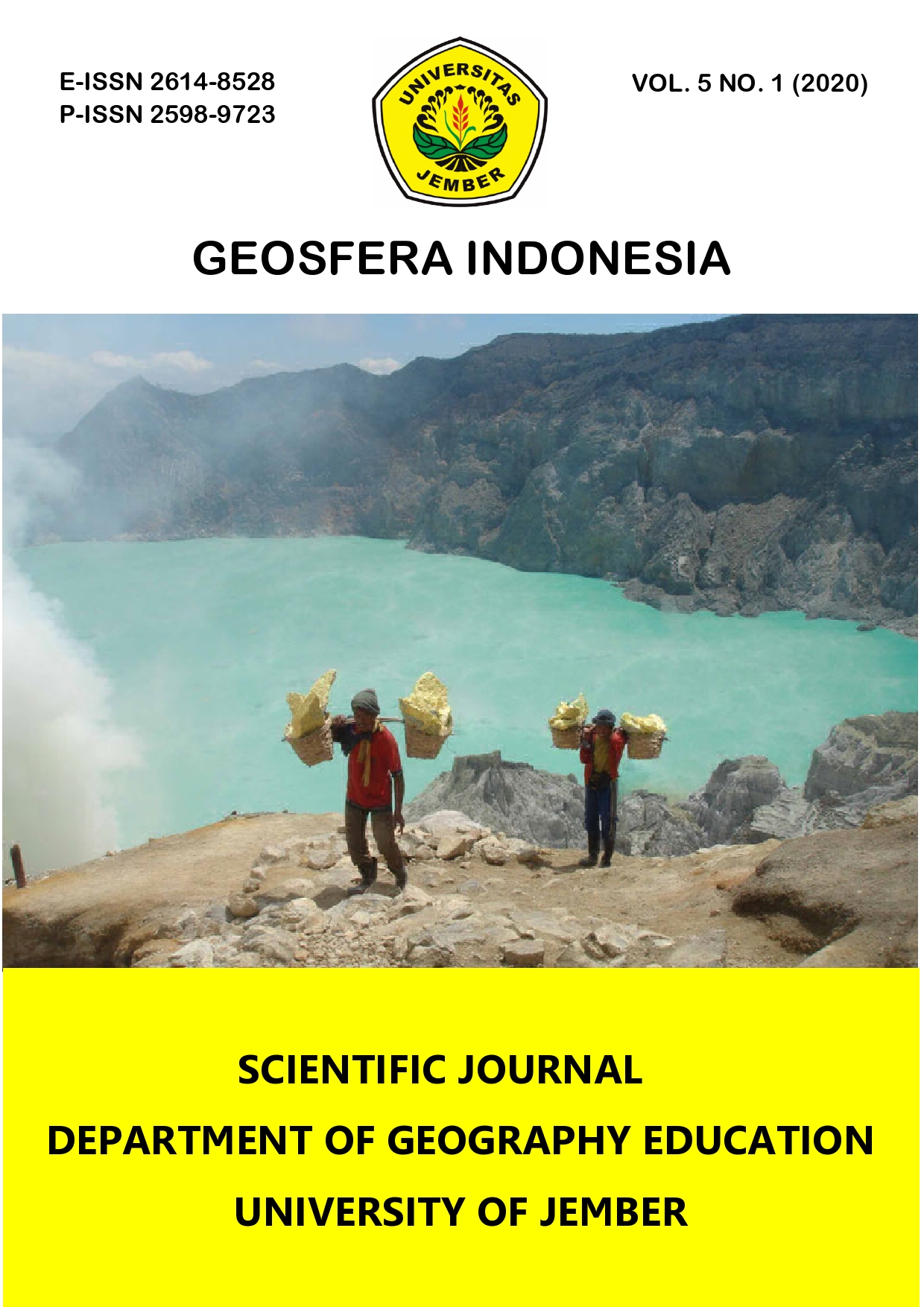Water Poverty Assessment in Olorunsogo Local Government Area of Oyo State, Nigeria
DOI:
https://doi.org/10.19184/geosi.v5i1.13438Keywords:
Water Poverty, Access, Capacity, Uses, Environment, Resources, Factor AnalysisAbstract
Poor access to water is often linked to poverty, human welfare, health, nutritional status, and household labour. This paper is aimed at contributing to the debate surrounding water poverty in the rural areas. Primary data obtained covering water resources, access, capacity, uses, and environment were collected using closed-ended questionnaires. Altogether, 370 household heads were sampled and were selected by systematic random sampling technique. Multiple correlations, factor analysis and multiple regression methods were used to determine the level of relationship between the Water Poverty Index (WPI) components. The results revealed that: WPI is the highest in Elenke/Sagbo (72.3%) and the lowest in Onigbeti II/Sagbon (55.5%). Also, WPI has a strong positive relationship with resources (r = .656), capacity (r = .705) and environment at 95%. Percentages of explanations of WPI ranges from 86.45% in Onigbeti I to 50.99% in Aboke.The results of multiple regression between WPI and components showed that components were weak predictors in 5 wards (Onigbeti III &IV, Onigbeti II , Onigbeti I, Seriki Agbele Aboke and Abogun wards). The paper posits that access to water in Olorunsogo Local Government Area (LGA) is generally reasonable. The paper suggests stronger government presence to improve and sustain the level of access.
Keywords : Water Poverty; Access; Capacity; Uses; Environment; Resources; Factor Analysis
Copyright (c) 2020 Geosfera Indonesia Journal and Department of Geography Education, University of Jember

This work is licensed under a Creative Commons Attribution-Share A like 4.0 International License
Downloads
References
Carrard, N., Madden, B., Chong, J., Grant, M., Nghiêm, T. P., Bùi, L. H., . . . Willetts, J. (2019). Are piped water services reaching poor households? empirical evidence from rural viet nam. Water Research, 153, 239-250. doi:10.1016/j.watres.2019.01.026
Davis, M. F., & Ryan, N. (2017). Inconvenient human rights: Water and sanitation in Sweden’s informal roma settlements. Health and Human Rights, 19(2), 61-72.
Falkenmark, M. and Rockström, J. (2004).Balancing Water for Humans and Nature- the new Approach in Ecohydrology.London: Earth scan.
Falkenmark, M., Lundqvist, J., &Widstrand, C. (1989).Macro-scale water scarcity Federal Republic of Nigeria (2000), Water Supply and Sanitation Interim Strategies Note
Fenwick, C. (2019). Identifying the Water Poor: An Indicator Approach to Assessing Poverty in Rural Mexico. A PhD Thesis submitted to Department of Civil, Environmental and Geomatic Engineering, University College, London. Pg. 270.
Guppy, L. (2014) the water poverty index in rural Cambodia and Vietnam: a holistic snapshot to improve water management planning. Natural Resources Forum. 38: 203-219
Harmanny, K. S., & Malek, Ž. (2019). Adaptations in irrigated agriculture in the mediterranean region: An overview and spatial analysis of implemented strategies. Regional Environmental Change, 19(5), 1401-1416. doi:10.1007/s10113-019-01494-8
Hoque, S. F., Hope, R., Arif, S. T., Akhter, T., Naz, M., & Salehin, M. (2019). A social-ecological analysis of drinking water risks in coastal bangladesh. Science of the Total Environment, 679, 23-34. doi:10.1016/j.scitotenv.2019.04.359
Ifabiyi I.P. & Ogunbode T. O. (2014): The Use of Composite Water Poverty Index in Assessing Water Scarcity in the Rural Areas of Oyo State Nigeria. An International Journal of Science and Technology, 3 (2):51-65.
Kallio, M., Guillaume, J. H. A., Kummu, M., & Virrantaus, K. (2018). Spatial variation in seasonal water poverty index for laos: An application of geographically weighted principal component analysis. Social Indicators Research, 140(3), 1131-1157. doi:10.1007/s11205-017-1819-6
Kini, J. (2017). Inclusive water poverty index: A holistic approach for helping local water and sanitation services planning. Water Policy, 19(4), 758-772. doi:10.2166/wp.2017.075
Maheswari, J.U. & Chaithanya, S.M. (2015) water poverty index facts and figures- A review. International Civil Engineering Symposium. DOI: 10.13140/RG.2.13681.1369.
Mohmmed, A., Zhang, K., Kabenge, M., Keesstra, S., Cerdà , A., Reuben, M., . . . Ali, A. A. S. (2018). Analysis of drought and vulnerability in the north darfur region of sudan. Land Degradation and Development, 29(12), 4424-4438. doi:10.1002/ldr.3180
Ngarava, S., Zhou, L., & Monde, N. (2019). Gendered water insecurity: A structural equation approach for female headed households in south africa. Water (Switzerland), 11(12) doi:10.3390/w11122491
Panthi, J., Khatiwada, K. R., Shrestha, M. L., & Dahal, P. (2019). Water poverty in the context of climate change: A case study from karnali river basin in nepal himalaya. International Journal of River Basin Management, 17(2), 243-250. doi:10.1080/15715124.2018.1531421
Sullivan, C. (2002), Calculating a water poverty index. World Development Journal, 30 (7): 1195-1210.
Umamahheswari, J., Bukke, S. & Chaithanya, S.M. (2017) Water poverty index as a water management :A micro level study in Tamil Nadu, India. A Paper Presented 6thConference on Water and Food Management (ICWFM, 2017)



